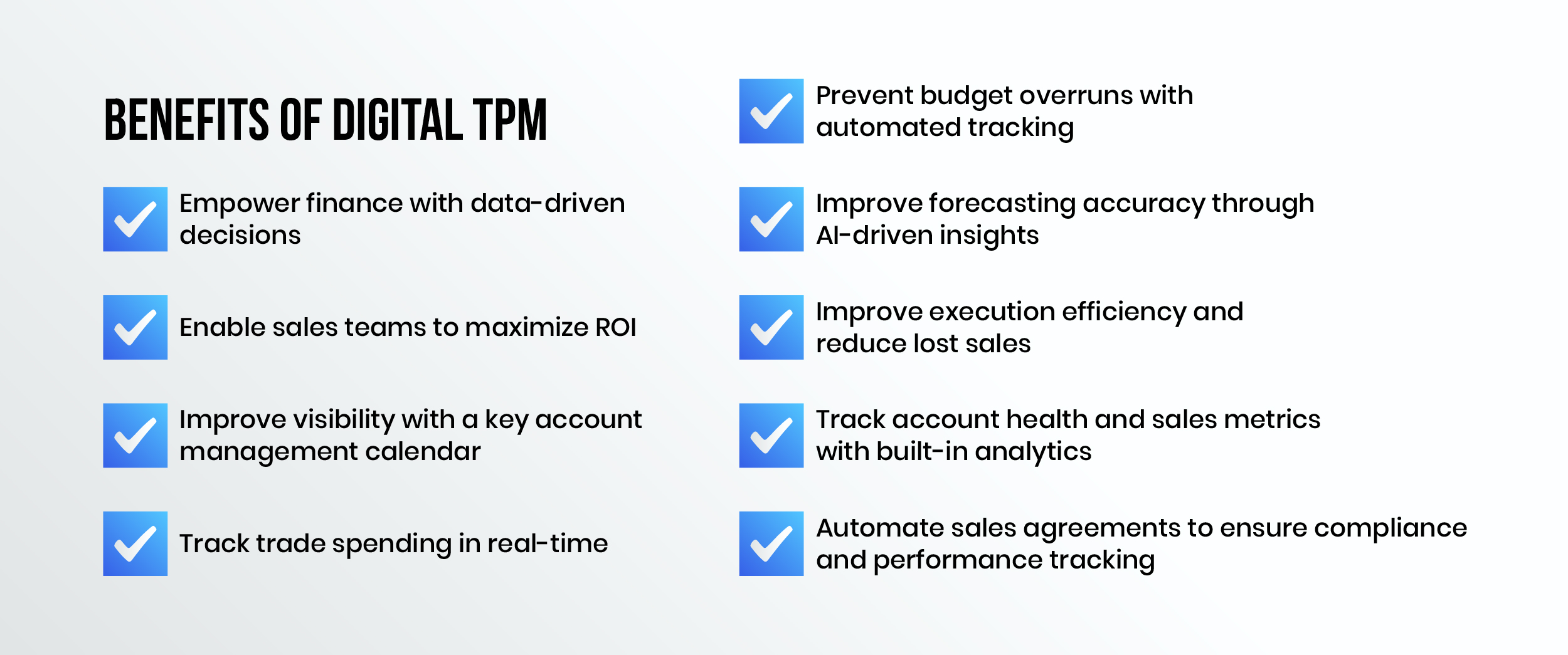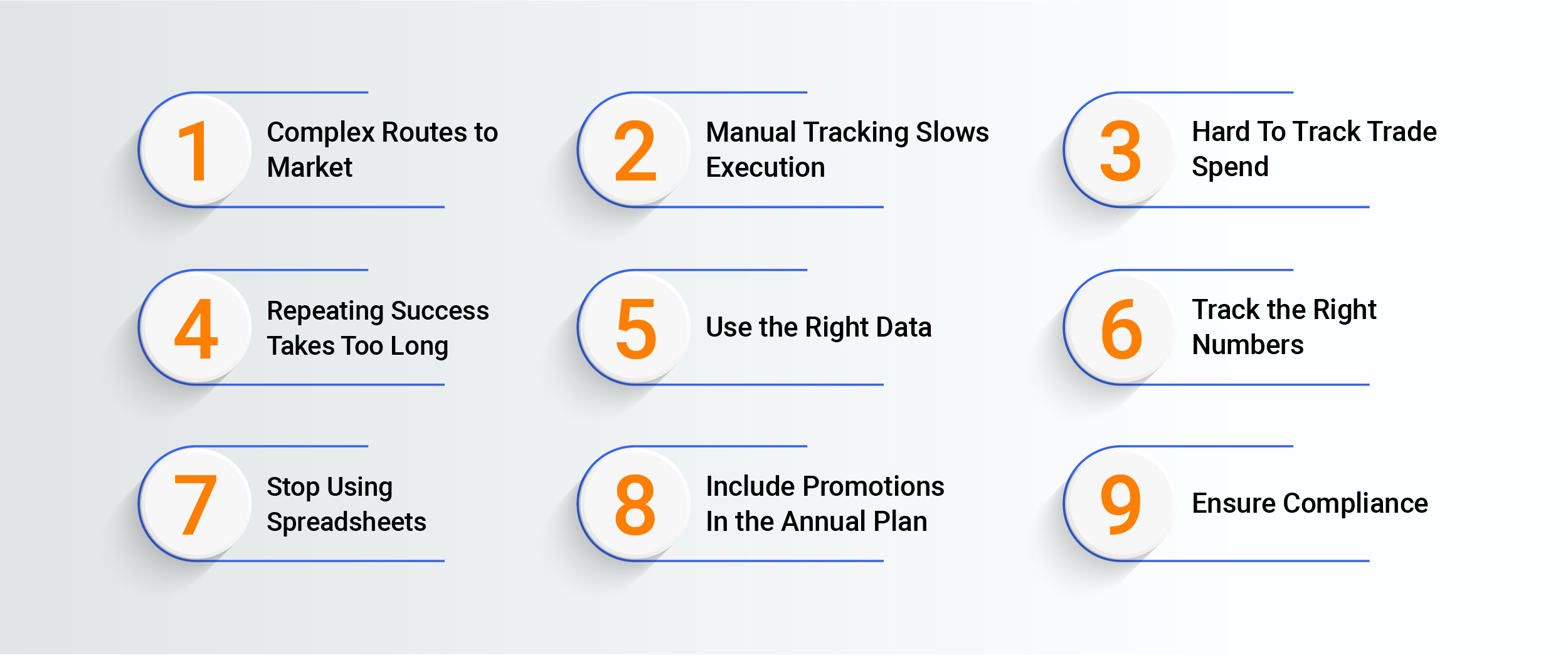Consumer goods companies spend millions on promotions, yet 72% don’t break even due to poor execution. Trade promotions boost sales through discounts and retailer incentives. But over half of these promotions don’t make a profit. CPG brands spend over $500 billion a year on trade promotions, according to Forrester. With so much money invested, it’s important to run them correctly and boost sales.
The cost of trade promotions has jumped from 3% to over 25% of revenue. Even with this big spend, many companies don’t see the expected sales boost. Retailers now depend on these funds, turning them into a major part of their profits.
To grow well, businesses must master trade promotions. Here’s how.
What is Trade Promotion Optimization (TPO)?

TPO helps businesses plan better promotions using data instead of guesswork. It analyzes, plans, runs, and reviews promotions for better results.
TPM is about running promotions, managing budgets, and handling logistics. TPO plans future promotions using past sales, trends, and customer behavior. Both are important, but TPO helps businesses spend smarter and get better results. Old promotion methods often lead to wasted money and poor results. TPO uses data to align promotions, cut waste, and boost profits.
Retailers use Trade Promotion Optimization to make promotions more useful. One key strategy is, Targeted discounts to reward loyal customers based on shopping habits. Flexible pricing adjusts based on demand and competition, like flash sales. Bundled deals also help boost sales by pairing related products, like chips with salsa or shampoo with conditioner, at a discount. Moreover, Seasonal promotions boost sales with holiday and event-based discounts.
Walmart is a great example of using pricing strategies to dominate the grocery market. Lowering prices pressure competitors to follow, reshaping pricing strategies. As shopping habits shift, more consumers seek affordable options, helping stores like Costco and Aldi grow. To stay competitive, businesses need smart pricing and promotions. To install TPO, firms set goals, use analytics, train teams, and track results. AI and smart tools are shaping the future of TPO.
Finance teams need real-time insights to divide budgets. 58% of businesses lack tools to track trade funds, risking billions. Sales teams spend 25% of their time managing promotions, often without the right tools. TPM streamlines account planning, reduces trade overspend, and enhances customer communication.
According to Forbes, Great businesses go beyond problem-solving; they help clients succeed long-term. Clients see them as a quick fix instead of long-term partners. To change this, focus on success, not solutions. A doctor treats issues; a trainer builds long-term health. Businesses can do both and build stronger relationships.
Start by specializing in a specific industry. This helps attract the right clients and makes your services more valuable. For example, an accounting firm focused on SaaS companies can give better insights. Next, understand what success means for your clients. Every business has different goals, and a personalized approach builds trust. Helping clients build lasting partnerships and boost profits.
Key Benefits of Digital TPM

- Empower finance with data-driven decisions
- Enable sales teams to maximize ROI
- Improve visibility with a key account management calendar
- Track trade spending in real-time
- Prevent budget overruns with automated tracking
- Improve forecasting accuracy through AI-driven insights
- Improve execution efficiency and reduce lost sales
- Track account health and sales metrics with built-in analytics
- Automate sales agreements to ensure compliance and performance tracking
The Problem: Inefficient Promotions
Despite massive budgets, most promotions underperform.
“Winning Through More Insightful, Better Executed Promotions” – Promotion Optimization Institute
Many companies struggle to identify and scale their most profitable promotions. The culprit? Data inefficiency. 60% of businesses still use spreadsheets, missing real-time data and AI insights. To compete, companies must move from tracking to strategy. The right digital tools can transform trade spend management. The solution is Modernizing Trade Promotion Management (TPM)
Solving Trade Promotion Challenges

1. Complex Routes to Market
Standard promotions no longer function. Firms must customize promotions by channel, area, and even store level. A digital TPM system enables real-time, targeted promotions like spring beach towel discounts.
2. Manual Tracking Slows Execution
Spreadsheets are bulky, prone to mistakes, and lack real-time updates. Digital TPM eases data automates reports, and aligns stakeholders.
3. Hard To Track Trade Spend
Most companies don’t know which promotions drive revenue and which waste money. Automated analytics help track success, adjust strategies, and maximize ROI.
4. Repeating Success Takes Too Long
Without a streamlined system, companies waste time rebuilding successful promotions from scratch. Digital TPM allows instant replication, freeing teams to focus on strategy and partnerships.
5. Use the Right Data
Using the right data is the key to successful trade promotions. In the past, poor data quality made it hard to get good results, but new technology has changed that.
AI and data science now help predict and improve promotions. Key data includes past promotions, sales, supply chain, and marketing insights. Tracking past promotions helps plan better, while POS data shows real-time sales results. Aligning promotions with demand improves stock planning and boosts marketing impact.
6. Track the Right Numbers
To improve trade promotions, companies need to track the right numbers. They should track promotion details like dates, costs, and pricing. It’s also important to track claims, deductions, and fund transfers. Tracking compliance, costs, and sales data ensures effective promotions. Keeping an eye on these numbers makes it easier to manage promotions and get better results.
7. Stop Using Spreadsheets
Managing trade promotions with spreadsheets is slow, error-prone, and outdated. Companies should use modern software to track promotions, payments, and results automatically.
8. Include Promotions In the Annual Plan
Trade promotions shouldn’t be last-minute decisions. Include them in annual plans to align with sales, marketing, and inventory.
9. Ensure Compliance
Retailers must ensure correct pricing and enough stock for promotions. Teams must follow policies to cut waste and boost efficiency.
Effective Trade Promotion Management

Businesses must execute trade promotions right to maximize investment. Colin Bunn (2020) says businesses should focus on improving promotions rather than running them. To do this, companies should set clear goals and track results. Many promotions fail because businesses repeat old plans without checking if they work. Key metrics like sales increase, promotion lift, and ROI help measure success.
Product displays also matter. Product placement impacts visibility. Eye-level items sell faster, and clear signage attracts shoppers. Discounts are also important. Since 93% of U.S. clients look for deals, businesses should plan discounts at the right time, like during peak shopping seasons. Flash sales and temporary price cuts can boost sales.
Coupons and promo codes boost loyalty and reveal shopper preferences. Using data is key. It helps businesses see what’s working and make quick changes if needed. This leads to better sales and profits. By following these steps, businesses can run successful promotions.
Conclusion
With tightening margins, consumer goods companies must maximize ROI on trade promotions. Digital TPM enables smarter decision-making and faster execution. It also strengthens retailer relationships, creating a win-win for all.

